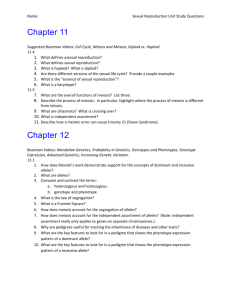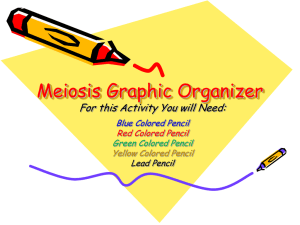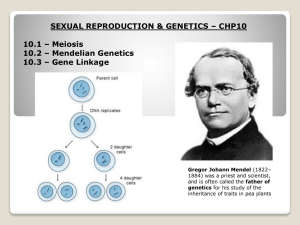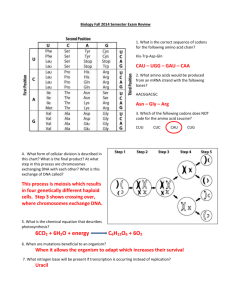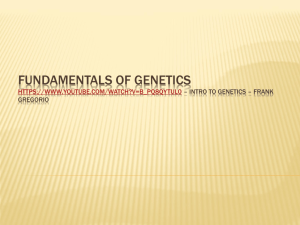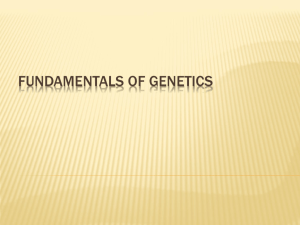Chapter 13 and 14 Test Name 41pts. Which of the following best
advertisement
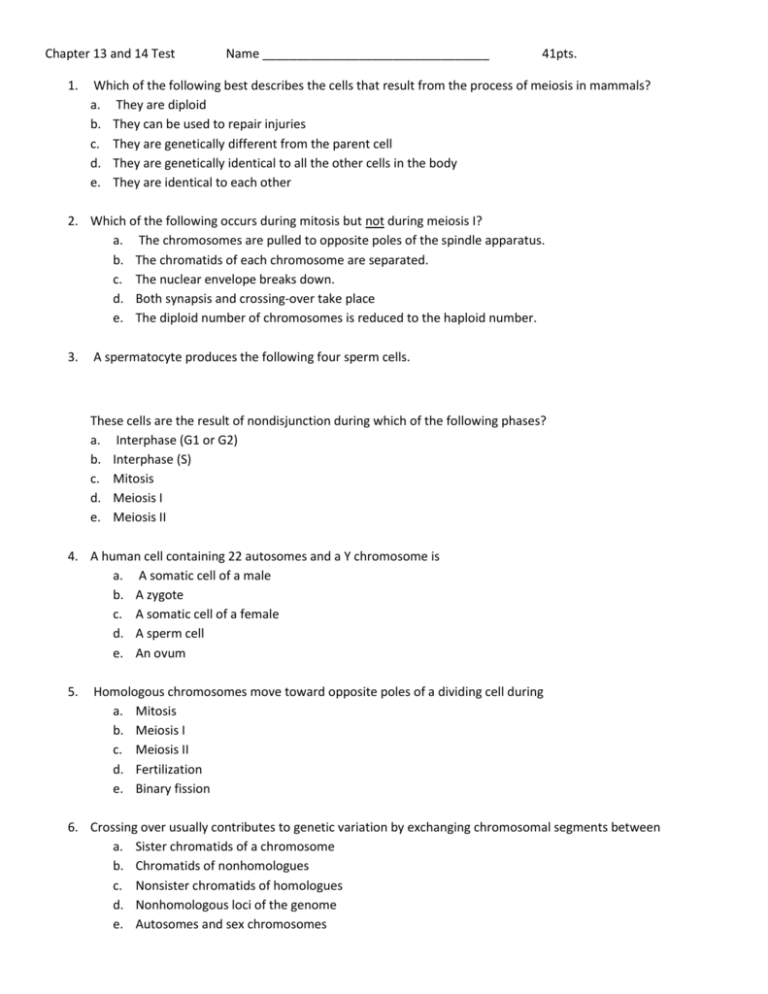
Chapter 13 and 14 Test 1. Name _________________________________ 41pts. Which of the following best describes the cells that result from the process of meiosis in mammals? a. They are diploid b. They can be used to repair injuries c. They are genetically different from the parent cell d. They are genetically identical to all the other cells in the body e. They are identical to each other 2. Which of the following occurs during mitosis but not during meiosis I? a. The chromosomes are pulled to opposite poles of the spindle apparatus. b. The chromatids of each chromosome are separated. c. The nuclear envelope breaks down. d. Both synapsis and crossing-over take place e. The diploid number of chromosomes is reduced to the haploid number. 3. A spermatocyte produces the following four sperm cells. These cells are the result of nondisjunction during which of the following phases? a. Interphase (G1 or G2) b. Interphase (S) c. Mitosis d. Meiosis I e. Meiosis II 4. A human cell containing 22 autosomes and a Y chromosome is a. A somatic cell of a male b. A zygote c. A somatic cell of a female d. A sperm cell e. An ovum 5. Homologous chromosomes move toward opposite poles of a dividing cell during a. Mitosis b. Meiosis I c. Meiosis II d. Fertilization e. Binary fission 6. Crossing over usually contributes to genetic variation by exchanging chromosomal segments between a. Sister chromatids of a chromosome b. Chromatids of nonhomologues c. Nonsister chromatids of homologues d. Nonhomologous loci of the genome e. Autosomes and sex chromosomes 7. (Assume that the alleles referred to all assort independently.) Probability that the genotype Aa will be produced by the parents Aa x Aa a. 0 b. 1/16 c. ¼ Aa d. ½ e. 3/4 8. (Assume that the alleles referred to all assort independently.) Probability that the genotype ccdd will be produced by the parents CcDd x CcDd a. 0 b. 1/16 c. ¼ d. ½ e. ¾ 9. (Assume that the alleles referred to all assort independently.) Probability that the genotype Rr will be produced by the parents Rr x rr. a. 0 b. 1/16 c. ¼ d. ½ e. ¾ 10. (Assume that the alleles referred to all assort independently.) Probability that the genotype TTSs will be produced by the parents TTSs x TtSS a. 0 b. 1/16 c. ¼ d. ½ e. 3/4 11. A couple has 5 children, all sons. If the woman gives birth to a sixth child, what is the probability that the sixth child will be a son? a. 5/6 b. ½ c. 1/5 d. 1/6 e. 1/64 12. Assume that the genes A and B are not linked. If the probability of allele A in a gamete is ½ and the probability of allele B in a gamete is ½, then the probability that both A and B are in the same gamete is a. ½ x ½ b. ½ + ½ c. ½ ÷ ½ d. Square root of ½ e. | ½ - ½ | 13. Which of the following best describes the parents in a testcross? a. One individual has the dominant phenotype and the other has the recessive phenotype b. Both individuals are heterozygous c. Both individuals have the dominant phenotype d. Both individuals have the recessive phenotype e. Both individuals have an unknown phenotype 14. In sheep, eye color is controlled by a single gene with two alleles. When a homozygous brown-eyed sheep is crossed with a homozygous green-eyed sheep, blue-eyed offspring are produced. If the blue-eyed sheep are mated with each other, what percent of their offspring will most likely have brown eyes? a. 0% b. 25% c. 50% d. 75% e. 100% 15. In peas the trait for tall plants is dominant (T) and the trait for short plants is recessive (t). The trait for yellow seed color is dominant (Y) and the trait for green seed color is recessive (y). A cross between two plants results in 296 tall yellow plants and 104 tall green plants. Which of the following are most likely to be the genotypes of the parents? a. TTYY x TTYY b. TTyy x TTYy c. TtYy x TtYy d. TtYy x TTYy e. TtYY x Ttyy 16. Which of the following is the most likely explanation for a high rate of crossing-over between two genes? a. The two genes are far apart of the same chromosome b. The two genes are both located near the centromere c. The two genes are sex-linked d. The two genes code for the same protein e. The two genes are on different chromosomes 17. Carriers of a genetic disorder a. Are indicated by solid symbols on a family pedigree b. Are involved in consanguineous matings c. Will produce children with the disease d. Are heterozygotes for the gene that can cause the disorder e. Have a homozygous recessive genotype 18. (3pts) Describe the difference between the following vocab words. Drawing a labeled picture may help. Chromosome, Loci, Gene, Allele 19. (4pts) Describe how sexual reproduction (random fertilization and the process of meiosis) can lead to genetic variation. 20. (3pts) Describe THREE reasons why Mendel’s experiments allowed him to be successful. 21. (2pts) Even though Mendel’s writings were from the 1850s why he not appreciated until about 1910? 22. (2pts) What did Mendel provide to Darwin’s theory of evolution? Free Response Question (10pts): Meiosis reduces chromosome number and rearranges genetic information. (a) Explain how the reduction and rearrangement are accomplished in meiosis. (b) Several human disorders occur as a result of defects in the meiotic process. Identify ONE such chromosomal abnormality; what effects does it have on the phenotype of people with the disorder? Describe how this abnormality could result from a defect in meiosis. (c) For some human disorders, pre-natal testing options are available along with subsequent genetic counseling. Describe what is being tested for in ONE of the many types of prenatal tests, what topics are being counseled, and what ethical issues arise from this process.

